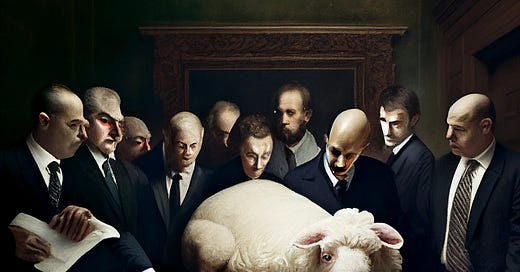Nightcap
End of a 40-year era of cheap capital in the mattress industry. Post-disruption Serta Simmons Bedding greets a new beginning.
Financial leverage works both ways. If Serta Simmons Bedding (“SSB”) performed well, Advent International's $3 billion investment in the mattress conglomerate could have easily doubled in equity value. Merged into the world’s largest mattress manufacturer in a feat of financial engineering, the SSB house of brands brought together Serta, Beautyrest, Simmons, and Tuft & Needle. However, the company's punishing debt load of $2 billion left little room to breathe when the world changed around it. The past year has been especially cruel to the business — reliving the nightmare from 2009 — as it writhed around, grasping for any pocket of liquidity within reach.
On January 23, 2023 at 11pm, SSB filed for Chapter 11 bankruptcy.
As tragic as it may be, we are witnessing a cleansing of the broader market, long overdue, to restore the harmony and the balance lost 35 years ago when a torrential tide of cheap capital swept in.
Leverage Derailed
Today's mattress industry looks a lot different compared to 2012 when Advent International developed the investment thesis for what would become Serta Simmons Bedding. First combined in 2009 as AOT Bedding Super Holdings by Ares Management and Ontario Teachers, Serta and Simmons were initially managed as separate entities. Serta’s headquarters remained in Chicago, and Simmons’ in Atlanta — each with its own CEO. Together these legacy brands dominated the distribution channel of mattress stores.
Serta is coming off one of the most successful years in bedding history. Sales for the Serta brand soared 26.7% last year, to $1.47 billion, as Serta lengthened its lead over No. 2 Sealy to $261 million. Simmons, with wholesale bedding shipments last year of just over $1 billion, is the No. 3 bedding producer.
Serta and Simmons seemed invincible as household names that would remain timeless no matter what. In August 2012, Advent raised $2 billion in debt to acquire control of the combined entity for a purchase price of $3 billion. Unlocking the synergies from what was perceived to be two bloated orgs should have easily paid back the purchase price and then some.
Advent International Corp. will use the new $1.233 billion term loan B and $725 million senior unsecured notes, along with $760 million new equity and $370 million of rollover equity from the company's current owners, to purchase a majority stake in the company for approximately $3 billion, refinance existing debt, and pay transaction fees.
Fast forward to today, consumers are less willing to pay higher prices for mattresses, which have become brutally commoditized over the past decade. For good reason: Mattress Stores Are Greedy billboards, birth of a mattress unicorn, Amazon's aggressive expansion into furniture, $250 green tea mattresses, and so on. Brands have to try harder. Competitive pricing is cutthroat. Claims about tech innovation need to be real. Millennials don’t want their grandparents’ hand-me-down brands. Even Amazon Prime is too slow.
By the end of the cycle, over 170 bed-in-a-box lookalikes were vying for attention wherever you turned online, from mattress ads flooding Google and Facebook to sponsoring all your favorite podcast shows. After the hundreds of millions of dollars in collective ad spend deployed by bed-in-a-box startups, consumers were properly conditioned to expect a quality mattress at a fair price with the click of a button.
The wave of disruption washed away many of the industry's past tricks and gimmicks. Price transparency and streamlined shopping experiences bred more discerning customers. Finally waking up to reality, traditional mattress retailers and manufacturers acknowledged the need to change the way they did business — or, as they like to say, to meet the consumer wherever she is. So in a promising move, in 2018, Serta Simmons Bedding merged with Tuft & Needle, the bed-in-a-box pioneer that flipped the industry on its head.
However, private equity’s zeal can quickly turn into impatience. Viewed through the cells of a financial model, EBITDA is the only source of truth. An over-leveraged company in distress is prone to suffer from bouts of amnesia, and it is doomed to relapse into old habits:
According to one study, expanding margins accounted for only 6% of private-equity value-creation during the past five years; as pricing-power becomes the focus of all firms, defending profitability will take priority over growth. The penalties for failing to adapt will be harsh. Hefty debt piles (average leverage in large American buy-outs is now more than seven times ebitda, the highest since 2007) make getting this right critical to avoiding the bankruptcy courts.
Unfortunately for cash cows, once neglected and undernourished, what was once easy milking will turn into squeezing blood. Now, the mattress industry faces downward-sloping demand, which ultimately impacts the bottom line for mattress manufacturers like SSB. A bottom line that used to be rich enough to pay off billions of dollars of debt.
Post-Pandemic Woes
Needless to say, the pandemic must take some blame. Serta Simmons Bedding was hit hard by the closures of retail stores and factories. Margins — key to extracting that sweet EBITDA — got crushed by increasing commodity, transportation, and labor costs.
In March before the coronavirus hit the US, the company — which in addition to Serta and Simmons owns the Beautyrest and Tuft & Needle brands — had $100 million on its balance sheet, and was generating more than $200 million in EBITDA, or earnings before interest, taxes depreciation and amortization, according to Moody’s Investor Service.
Conditions improved somewhat in 2021 and the first half of 2022. More recently, though, inflation, higher interest rates, and shifts in spending to other categories have all contributed to lower demand for SSB's core products. As ISPA's Ryan Trainer observed coming out of the 2008 recession, mattresses are a deferrable purchase, and consumers will just make do with what they have when money gets tight:
Experience shows that mattress sales are influenced strongly by trends in the national economy, especially by changes in consumers’ disposable income, sales of new and existing homes, and changes in consumers’ wealth.
According to ISPA data, the average selling price (AUSP) for total mattress sales grew 15.5% year-over-year in 2021 and grew over 8% in 2022. But this trend of price increases driven by inflation should not be mistaken for brand strength or pricing leverage.
When Things Fall Apart
By applying the state-of-the-art in financial engineering, private equity is supposed to help companies grow and thrive. Armed with loads of cheap capital and legions of ivy league MBAs, these investors resurrect dying companies, cut the fat from bloated organizations, accelerate lifetime profits, and generally take bigger risks for bigger rewards. But when a leveraged buyout goes wrong, the business turns into a self-perpetuating, self-feeding process of decline.
SSB’s dire situation as of September 2022:
Serta Simmons has $345 million of cash as of 2Q 2022 (down from $518 million at year-end 2021) and $171 million of capacity on its ABL revolver (factoring in $29 million letters of credit outstanding). Moody’s expects negative free cash flow of $125 million to $145 million over the next 12 months (including cash priority term loan interest payments that the company records as a financing outflow).
Then in December, heading into the holidays:
Serta Simmons Bedding is preparing to seek bankruptcy protection as soon as January, according to people with knowledge of the situation. The closely held mattress manufacturer has been in confidential talks with its creditors over a restructuring plan, which may involve giving control to certain first-lien lenders, said the people, who asked not to be identified because the matter is private.
When a company struggles to avoid breaching the secured leverage covenant ratio and pay the interest on its debt, it becomes heavily focused on profitability and maximizing short-term gains. This singular attention on survival leaves little time and patience for creative experimentation or innovation, which ironically makes the bad situation worse. The flywheel begins spinning in the other direction, becoming the company's undoing.
#1: Hard to Gain, Easy to Lose
In a zero-sum environment like the mattress industry, each missed opportunity can be detrimental. The distraction from R&D and brand building further exacerbates the company’s financial struggles and leaves it vulnerable to what should be insignificant competitors.
Tempur-Sealy ($TPX) owns the Tempur-Pedic, Sealy, and Stearns & Foster brands. Despite having a similar profile as a legacy company conceived by financial innovation, Tempur managed to thrive in relative terms over the past couple of years.
From 2019 to 2021, TPX generated strong top-line of 15%, 18% and 34%, respectively, with revenue increasing to $4.9 billion from $2.7 billion and EBITDA, based on Fitch adjustments, increasing to $1.04 billion from $401 million.
In the latest Q3 business update, Tempur boasted a 20% gain in slots on mattress store floors:
We are pleased to share that we expect to expand our Stearns & Foster spots by third-party retailers in the U.S. by over 20%, demonstrating retailer support for our expansion strategy. To be clear, we believe the slot gains will be from competitors, not other Tempur Sealy brands. Many of these incremental slots will be filled with our new Stearns & Foster Lux Hybrid and our new Stearns & Foster Reserve Mattress.
Compared to SSB, Tempur did not necessarily do anything better — it just didn't do anything worse. Tempur’s product roadmap has largely been driven by a copycat strategy: bagged not boxed, sloppy seconds sleep tech, and a Purple mattress knockoff as shamelessly admitted:
As the largest bedding manufacturer in the world, there’s probably not a bed we can’t make if we believe that there’s a market there that’s worth attacking. And so we’re going to attack that market.”
Separately, no longer willing and able to sustain zombie companies, a non-ZIRP environment killed off many of the bed-in-a-box disruptors that had been frantically siphoning away sales. Waking up with a violent hangover, Silicon Valley VCs decided to stop funding unprofitable contenders in the mattress space — or actually DTC in general — and have moved onto more interesting pastures, like crypto and AI.
The second type of tech company is something like WeWork. This type of tech company is essentially a digital version of something that existed previously. These companies can gain traction due to the convenience factor unlocked by the digital transformation, but there isn't much extra value to capture. When interest rates were 0, VCs and the market as a whole were valuing these companies the same as true tech companies. Now that investors [are] more discerning with their money, the valuations of such companies is popping.
All the while, a business under the stress of debt curls itself into a ball — in obligation towards a covenant ratio, shedding dead weight, but at the same time losing much of the essence that made it successful in the first place.
A forthcoming reboot would be a cleansing sacrifice. The timing is ideal in the market for SSB’s brands to shake off the shackles and re-emerge. What that means is yet to be seen, but I am hopeful.
Regardless of how the SSB bankruptcy unfolds, we should feel reawakened by the opportunity in the mattress industry that continues to need fixing and fresh perspectives.
A powerful quote from Apollo CEO Marc Rowan: “You want chaos, you want things to be shaken up, you want the system to brought down and built up again. Just when you think the world is coming to an end and things are never going to get better, that is the time to build a career and build the next great fortune.”





